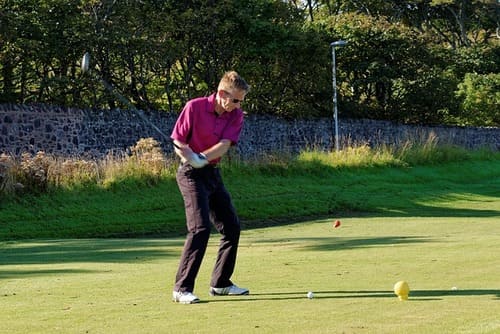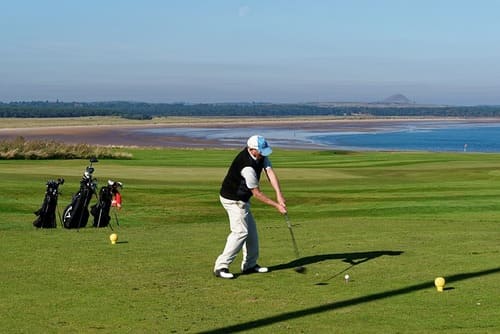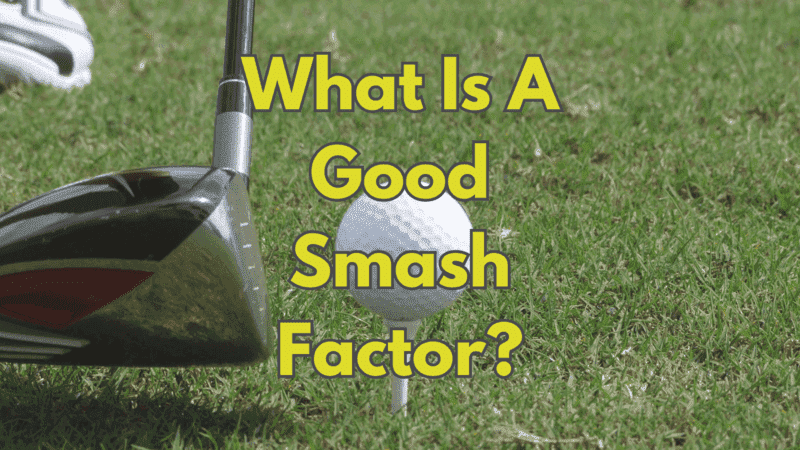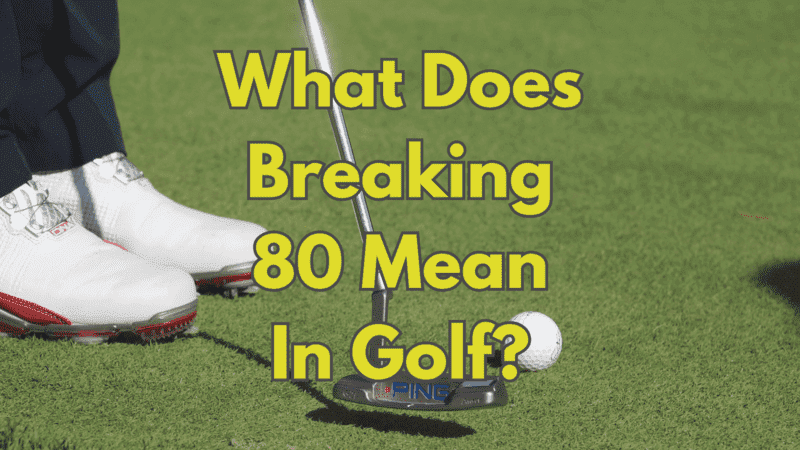Fore! It’s time to tee off on a journey into the fascinating world of golf metrics, and today, we’re diving headfirst into the exciting realm of “Smash Factor.” Whether you’re a seasoned golfer with a swing smoother than a gentle breeze, or a newcomer who’s still figuring out your putter from your driver, you’ve likely heard the term “Smash Factor” being thrown around the course.
But what in the world is this metric, and why does it matter? Well, it’s not about smashing your golf club into the ground in frustration after a missed putt (we’ve all been there!). Instead, it’s a vital piece of the golf puzzle, a secret code that can unlock the power, precision, and, dare we say, the magic of your swing.
In this blog post, we’ll dissect the enigma that is Smash Factor, demystify the jargon, and equip you with the knowledge you need to elevate your golf game to new heights. Get ready to unleash the golfer in you, as we embark on this thrilling journey to discover just what makes a good Smash Factor and why it’s the Holy Grail for golfers seeking excellence on the fairway. So, grab your clubs, strap on your golf shoes, and let’s tee up this adventure together!
Smash Factor Explained: Understanding the Basics
Smash Factor is a crucial concept in golf that relates to the efficiency of impact between the golf ball and the clubface. It is essentially a measurement that indicates how well a golfer is able to transfer energy from the clubhead to the ball during a shot. The higher the Smash Factor, the more efficient the impact, resulting in increased ball speed and ultimately greater distance. Understanding the basics of Smash Factor is fundamental in improving your golf game and achieving optimal performance on the course.
To calculate Smash Factor, you need two key pieces of information: ball speed and clubhead speed. Ball speed refers to the velocity of the ball as it leaves the clubface, while clubhead speed is the speed at which the clubhead is traveling at impact. By dividing ball speed by clubhead speed, you can determine the Smash Factor of a particular shot. For example, a ball speed of 140 mph divided by a clubhead speed of 100 mph would result in a Smash Factor of 1.4. It is important to note that the maximum rating achievable is 2.0, which indicates a perfect transfer of energy.
Factors That Affect Smash Factor
There are several key factors that can affect your smash factor in golf. One of the most significant factors is the quality of contact between the clubface and the ball. When the clubface makes solid and centered contact with the ball, it maximizes energy transfer and leads to a greater transfer of energy. On the other hand, off-center hits or missed sweet spots result in reduced efficiency and lesser power.
Another factor that plays a crucial role in smash factor is club speed. The speed at which you swing the club directly impacts how much energy is transferred to the ball upon impact. A faster swing speed can generate more power and increase the likelihood of achieving a higher smash factor. It’s important to note that while swing speed is important, it must be balanced with proper technique and control to optimize smash factor effectively.
The Importance of Smash Factor in Golf
When it comes to the game of golf, there are many factors that can affect your performance. One such factor that plays a crucial role in determining the success of your shots is the smash factor. Smash factor refers to the ratio of the ball speed to the clubhead speed. It is essentially a measure of how efficiently you transfer the energy from the clubhead to the golf ball.
Understanding the importance of smash factor is essential for golfers who want to improve their game. A high rating indicates that you are making solid contact with the ball and maximizing your distance potential. On the other hand, a low rating suggests that there is room for improvement in your swing mechanics. By focusing on improving this metric, you can optimize your shots for maximum distance and accuracy.

How to Calculate Smash Factor
In order to calculate the smash factor, you will need two pieces of information. The ball speed and the club head speed. The ball speed is the speed at which the ball leaves the clubface after impact. While the club head speed is the speed at which the clubhead is moving just before impact. Both of these measurements are typically recorded using a launch monitor or a similar device.
To calculate this metric, simply divide the ball speed by the club head speed. The formula looks like this:
Smash Factor = Ball Speed / Club Head Speed
For example, if the ball speed is measured at 150 miles per hour and the club head speed is measured at 100 miles per hour, the smash factor would be 1.5. This means that for every mile per hour of club head speed, the ball achieves 1.5 miles per hour of ball speed. In general, a higher smash factor indicates more efficient energy transfer from the clubhead to the ball. This results in greater distance off the tee.
Optimizing for Maximum Distance
To optimize your smash factor for maximum distance, it is crucial to focus on two key areas: club speed and center face contact. Club speed refers to the velocity at which the clubhead is moving as it strikes the ball, while center face contact refers to the point on the clubface where the ball makes contact.
To achieve maximum distance, increasing club speed is essential. This can be achieved through proper technique and body rotation during the swing. A smooth and balanced swing that generates power from the ground up can help maximize club speed. Additionally, maintaining a consistent tempo and rhythm throughout the swing can contribute to increased club speed and, consequently, a higher smash factor.
Equally important is center face contact. Striking the ball on the sweet spot of the clubface allows for maximum energy transfer from the club to the ball, resulting in optimal distance. Practicing and refining your swing mechanics can help improve your ability to consistently make solid contact with the center of the clubface. It is also important to select the right equipment. Such as clubs with larger sweet spots. This enhances your chances of achieving optimal center face contact and maximizing your smash factor for maximum distance.
Common Mistakes
One of the most common mistakes that golfers make when it comes to smash factor is improper clubface alignment. It is crucial to have the clubface square to the target at impact in order to maximize this metric. If the clubface is open or closed, it can result in off-center hits and a decrease in energy transfer. To avoid this mistake, golfers should focus on proper alignment during setup and maintain a neutral clubface position throughout the swing.
Another mistake that can greatly affect this metric is improper ball position. The position of the ball in relation to the clubface at impact is critical for achieving optimal smash factor. If the ball is too far back in the stance, it can lead to a downward strike and lower smash factor.
On the other hand, if the ball is too far forward, it can cause a shallower angle of attack. This will decrease the smash factor as well. Golfers should experiment with different ball positions and find the one that allows them to achieve solid contact and maximize their power.
Tips and Drills to Improve Your Smash Factor
Many golfers strive to improve their smash factor for maximum distance and accuracy. Fortunately, there are several tips and drills that can help you enhance your power. Firstly, focusing on your tempo and timing is crucial. A smooth and well-timed swing can generate a higher data point. Practice swinging at different speeds to find the optimal tempo that allows you to make solid contact with the ball consistently. Additionally, maintaining a stable head position throughout the swing is essential. Keeping your head steady and still will improve your balance and help you make better contact with the ball, resulting in a higher smash factor.
Another tip to improve this metric is to optimize your equipment. Begin by ensuring that your driver is properly fitted to your swing characteristics. The shaft flex, loft, and clubhead design all play a role in determining your smash factor. Consulting with a professional club fitter can provide valuable insights into selecting the right equipment for your game.
Additionally, experimenting with different golf balls can also impact your smash factor. Some balls are specifically designed to enhance distance and generate greater power, so finding the right ball that suits your swing and game style can make a significant difference. Remember, regular practice and implementation of these tips and drills will help you improve and ultimately enhance your overall golf game.

The Role of Equipment
When it comes to understanding the role of equipment in smash factor, it is important to realize that the type of clubs and balls you use can have a significant impact on your overall performance. The club’s design, loft angle, and shaft stiffness all play a part in determining how effectively the energy from your swing is transferred to the ball. Additionally, the type of ball you choose can affect the compression and spin, ultimately influencing the smash factor.
To optimize your smash factor, it is crucial to consider the specifications of your equipment. A club with a higher loft angle may generate more ball height but sacrifice some distance, while a lower loft angle can optimize distance but decrease shot trajectory. Likewise, using a ball with a higher compression may result in better energy transfer, leading to a higher smash factor. By understanding the role that equipment plays and tailoring your choices to match your swing style and desired outcome, you can maximize your chances of achieving optimal results on the golf course.
How to Use Smash Factor to Evaluate Your Game
To evaluate your game effectively, it is crucial to understand how to use smash factor as a valuable metric. Smash factor measures the efficiency of your contact with the ball and is calculated by dividing the ball speed by the clubhead speed. This metric provides insight into how well you are transferring energy from the clubhead to the ball, indicating the quality of your impact and the potential distance you can achieve.
By analyzing your smash factor, you can gain valuable feedback on the consistency and effectiveness of your swings. A high smash factor indicates that you are striking the ball efficiently, while a lower rating suggests room for improvement in your technique. Keeping track of your data over time allows you to identify any patterns or trends in your game that may need attention.
For example, if you notice a consistently low smash factor, it might be a sign that you need to work on your ball-striking skills, such as improving your swing mechanics or finding a better club fit. On the other hand, a consistently high smash factor could indicate that you are making solid contact and generating maximum distance, giving you confidence in your swing.
Smash Factor vs. Swing Speed: Understanding the Difference
In golf, two important factors to consider when evaluating your swing performance are smash factor and swing speed. While both of these terms are often used interchangeably, they actually represent different aspects of your swing technique.
Swing speed refers to the velocity at which the clubhead moves during your swing. It is typically measured in miles per hour (mph) and represents how fast you are able to generate clubhead speed. Swing speed is influenced by factors such as your physical strength, flexibility, and technique. A higher swing speed can lead to greater ball speed and longer shots, but it does not necessarily guarantee optimal shot efficiency.
On the other hand, smash factor is a measure of how effectively you transfer energy from the clubhead to the golf ball. It is calculated by dividing the ball speed by the clubhead speed. Simply put, smash factor reflects the efficiency of your impact with the ball. A higher metric indicates a more efficient transfer of energy and typically results in longer shots. However, it is important to note that this can vary depending on different factors. Such as clubface contact, angle of attack, and the type of golf club used.
FAQs
What is smash factor in golf?
Smash factor in golf is a term used to measure the efficiency of a golf shot. It is the ratio of ball speed to clubhead speed and indicates how well the clubhead transfers energy to the ball upon impact.
How is smash factor calculated?
Smash factor is calculated by dividing the ball speed by the clubhead speed. For example, if your ball speed is 150 mph and your clubhead speed is 100 mph, the smash factor would be 1.5.
What factors affect smash factor?
Several factors can affect smash factor, including the quality of the strike, clubhead speed, clubface angle, and the flex and design of the club shaft.
Why is smash factor important in golf?
Smash factor is important in golf because it directly affects the distance and accuracy of your shots. A higher smash factor indicates that you are delivering more energy to the ball, resulting in longer shots.
How can I optimize for maximum distance?
To optimize your smash factor for maximum distance, focus on improving your clubhead speed. Also, striking the ball in the center of the clubface, and maintaining a consistent clubface angle.
What are some common mistakes that affect smash factor?
Common mistakes that can negatively impact your power include hitting the ball off-center, having an incorrect clubface angle at impact, and using equipment that is not properly fitted for your swing.
Are there any tips and drills to improve my smash factor?
Yes, there are several tips and drills you can try to improve your smash factor, such as practicing with impact stickers, working on your swing tempo, and using drills to improve your clubhead speed.
How does equipment play a role in smash factor?
Equipment, such as clubs and balls, can play a significant role in smash factor. Using clubs that are properly fitted for your swing and using high-quality golf balls can help optimize this metric.
How can I use smash factor to evaluate my game?
You can use smash factor to evaluate your game by tracking your smash factor over time and comparing it to your average distances. This can help you identify areas for improvement and monitor the effectiveness of changes in your swing or equipment.
What is the difference between smash factor and swing speed?
Smash factor is the ratio of ball speed to clubhead speed. While swing speed refers to the speed at which the clubhead is moving during the swing. Swing speed is important, but this metric also takes into account how efficiently the energy is transferred to the ball.





